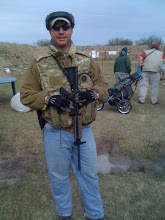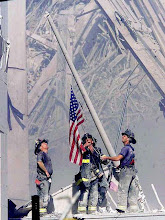It was a bitterly cold October day in 1995 when I walked into the Waukesha Co. Fairgrounds to take my Amateur Radio License exam. I borrowed my then girlfriend's car to make the thirty mile trip from Milwaukee to the Waukesha Ham Fest. Back then, the only experience I had with Ham Radio was borrowing a friend's Kenwood TS-140 to listen to the HF bands. The test was easy, and I passed with flying colors. When I received my license in the mail a couple of weeks later, I already knew what radio to ask "Santa" for when I came home on Christmas break.
That first radio was a Kenwood TH-79AD handheld. It opened up a whole new world for me. I entered a world of static crashes, dits and dahs of Morse code, and searching for contact from afar. Little did I know that I would be making contact with other countries via satellite, helping chase down tornadoes, and listening to the likes of Sputnik on its 40 year anniversary.
Ham radio has carried me farther since. I have participated in the annual Field Day events and still am an active listener. The last couple of years have seen a lull in my active participation, but with the imminent danger of Hurrican Rita, I came back to Ham Radio like a moth to a flame.
I have used my radio to listen to police and fire frequencies over the past several years. Public safety is a very exciting band to listen to. There is always something unique to hear and it provides a great source of information that is not watered down by MSM reports. By listening to police calls in my neighborhood, I can guage the level of crime and what areas to avoid. There are also the moments of sheer excitement as a fire rages or a pursuit is being transmitted over the airwaves.
As a Ham Operator, I am part of the public service realm, too. I provide directions to lost travellers, assist in events like the MS-150, and pass along disaster assistance traffic on coordinated nets. It is activities like this that make me a vital commodity in any community. I can and do provide this service free of charge and with only a person's thanks as my only form of payment.
There has been a lot of talk about communication failure during Rita and Katrina. What most of the public doesn't realize is that while their ability to communicate was limited to cell phones and email, others were working feverishly to pass along information to those coordinating rescue and relief. Ham Operators were able to pass along requests for water and food, conditions of their communities, and calls for rescue. We were like guardian angels letting those on the outside know what was and is happening.
My preparations for SHTF and extended time away from home almost always include Ham Radio. It helps to be able to communicate and receive information where it may not be normally available. I am not quite 100% on disaster preparedness, but I have the essentials ready to go.
Here's a look at my communication ability:
YAESU FT-8100R - Dual Band base/mobile transceiver. It can get 50W output on 2meters and 35 on 70cm. It has extended receive capability including the aircraft band up to about 1.3Ghz. This has become my emergency base station along with an Astron power supply and small dual band antenna (currently, it is being repaired due to lack of use).
YAESU FT-90 - Dual Band Mobile TXCVR. This 50/35 Watt mini-mite is fixed in my truck. It also has extended receive and an alpha-numeric display. It makes it easier for me to know what I am listening to. Also, the compact design and the removeable face-plate allow for different mounting possibilities.
YAESU VX-&R - Quad Band Hand-Held TXCVR. This handi-talkie transmits on 6m (50Mhz), 2m (144Mhz), 222 Mhz, and 440Mhz. It has a plethora of features like a signal analyzer to determine nearby active frequencies, directory of marine VHF/UHF channels, SW freqs for SW broadcast listening, extended receive from 1Mhz to 1.0Ghz, submersible, bright LED lamp, several memory groups to help organize certain blocks of frequencies. It also allows for alpha numeric labelling.
YAESU VX-1 - Dual Band Hand-Held TXCVR. This is the smallest production HT YAESU made. it also has extended receive and can transmit on 2m/440. I like this one for its low profile and small size. This is good for me when I am travelling through an airport and want to listen to the ATC witout looking like a terrorist plotting to take over an airplane.
KENWOOD TH-79AD - Dual Band Hand-Held TXCVR. My first radio! It can also receive airband and is MARS/CAP enabled. A great starter radio and I will probably pass it on to my kids if they get bit by the Ham Radio Bug.
All the YAESU radios now are equipped with a feature calld Auto Range Transponder System (ARTS). This is a nifty item that allows you to determine where another YAESU radio is operating. This only works if the other radio is receiving on the same frequency and using the same Digital Code Squelch. Pretty good thing to have if you are travelling in a group and might get separated.
Most all radios come standard with CTCSS, pl tones, and DCS for added security. You can configure a frequency to transmit one of these tones subaudibly to prevent eavesdropping, block access, or, more commonly, to prevent interference from nearby transmitters. Preventing harmful interference is more common in larger metropolitan areas. In a survival situation, having some sort of COMSEC (Communications Security) can be an aid to survival when and if unkind individuals attempt to bring harm to your group.
Ham Radios today pack a lot of punch. I probably have not bought my last radio. I plan on upgrading my license and gettin on the HF bands as soon as possible. A lot of changes to amateur radio today have made it more affordable and easier to get on the air. In recent years, the Morse code requirement (a hurdle that keeps most from joining the ranks) has been lowered to 5wpm from about 10-13wpm. It is fast going the way of the dinosaur, and recent talk has the FCC abolishing the code requirement altogether in a couple of years.
The licensing requirement is still fairly straightforward. All you need is some time to study and then take a test to get your license. Taking just the theory test will get you a No-Code Technician license. Right now, the Morse code requirement is 5wpm to get on the HF bands with a General class or higher ticket.
Of all the radio services available to the public; HAM, CB, FRS (Family Radio Service), GMRS (General Mobile Radio Service), HAM and CB are the two most popular. One requires a license, and the other doesn't. Citizen's Band is great for truckers and people travelling by car. You are able to get information about road conditions, the best hotels, and where the cops are hiding. The drawbacks for some are that it is unlicensed and attracts some very unsavory characters. Ham Operators take a small test and pay a fee for a license. With that license, they are able to do any myriad of things on the bands allocated to them. As opposed to CB's 40 channels on AM, Ham has an infinite number of frequencies for any number of purposes from Voice, Data, TV, Morse Code and on and on. Hams can operate in FM, AM, SSB and even light frequencies. Many ham radios today allow for scanning extended frequency bases like police and fire freqs. or even aircraft bands. Other public radio services don't offer this benefit on their radios.
As part of a person's Get Out Of Dodge Kit, one must consider the importance of being able to communicate. Whatever your level of preparation, you must consider what you are going to need to be heard. I highly recommend a Ham license and radio. There is a minimal investment in study and prep time and the dollar investment in a radio and accessories.
There are a great number of resources around for people to get involved in Ham radio. First and foremost, look at the ARRL (American Radio Relay League). This organization is a governing type body of Ham Radio across America. They have a wonderful site that has all you need to know to get licensed. Don't neglect your local Rat Shack as well. There you may find some basic literature and testing material. The tests are fairly simple and reading material usually includes a test pool that is recycled every couple of years. Most book stores have a couple of Ham magazines in their racks. CQ Magazine and Popular Communications are two of my favorites.
And don't forget to look around your neighborhood. See that neighbor a couple of blocks down? You know the one. He's the guy with a 100' tower sprouting the goofiest looking antenna you've ever seen. Knock on his door one day and ask to see his radio shack. Most of us Hams are more than willing to share our hobby with others who have an interest.
Next time, I will try and focus on specifics in what to look for in a ham radio.
It’s the People You Meet Along the Way
10 months ago


1 comment:
Nice piece.
In spite of the internet, ham radio is not dying and will not go away. There are just too many different modes to play with, too many different frequencies to try, too many countries that still need to be "worked", and too many emergencies that still manage to knock out every communication medium man has invented except ham radio.
Post a Comment